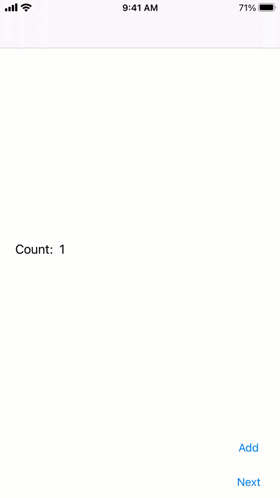Multiple Flutter screens or views
How to integrate multiple instances of Flutter engine, screens, or views to your application.
Scenarios
#If you're integrating Flutter into an existing app, or gradually migrating an existing app to use Flutter, you might find yourself wanting to add multiple Flutter instances to the same project. In particular, this can be useful in the following scenarios:
- An application where the integrated Flutter screen is not a leaf node of the navigation graph, and the navigation stack might be a hybrid mixture of native -> Flutter -> native -> Flutter.
- A screen where multiple partial screen Flutter views might be integrated and visible at once.
The advantage of using multiple Flutter instances is that each instance is independent and maintains its own internal navigation stack, UI, and application states. This simplifies the overall application code's responsibility for state keeping and improves modularity. More details on the scenarios motivating the usage of multiple Flutters can be found at flutter.dev/go/multiple-flutters.
Flutter is optimized for this scenario, with a low incremental memory cost (~180kB) for adding additional Flutter instances. This fixed cost reduction allows the multiple Flutter instance pattern to be used more liberally in your add-to-app integration.
Components
#
The primary API for adding multiple Flutter instances on both Android and iOS
is based on a new FlutterEngineGroup class (Android API,
iOS API)
to construct FlutterEngines, rather than the FlutterEngine
constructors used previously.
Whereas the FlutterEngine API was direct and easier to consume, the
FlutterEngine spawned from the same FlutterEngineGroup have the performance
advantage of sharing many of the common, reusable resources such as the GPU
context, font metrics, and isolate group snapshot, leading to a faster initial
rendering latency and lower memory footprint.
-
FlutterEngines spawned fromFlutterEngineGroupcan be used to connect to UI classes likeFlutterActivityorFlutterViewControllerin the same way as normally constructed cachedFlutterEngines. -
The first
FlutterEnginespawned from theFlutterEngineGroupdoesn't need to continue surviving in order for subsequentFlutterEngines to share resources as long as there's at least 1 livingFlutterEngineat all times. -
Creating the very first
FlutterEnginefrom aFlutterEngineGrouphas the same performance characteristics as constructing aFlutterEngineusing the constructors did previously. -
When all
FlutterEngines from aFlutterEngineGroupare destroyed, the nextFlutterEnginecreated has the same performance characteristics as the very first engine. -
The
FlutterEngineGroupitself doesn't need to live beyond all of the spawned engines. Destroying theFlutterEngineGroupdoesn't affect existing spawnedFlutterEngines but does remove the ability to spawn additionalFlutterEngines that share resources with existing spawned engines.
Communication
#Communication between Flutter instances is handled using platform channels (or Pigeon) through the host platform. To see our roadmap on communication, or other planned work on enhancing multiple Flutter instances, check out Issue 72009.
Samples
#
You can find a sample demonstrating how to use FlutterEngineGroup
on both Android and iOS on GitHub.

Unless stated otherwise, the documentation on this site reflects Flutter 3.38.1. Page last updated on 2025-10-28. View source or report an issue.